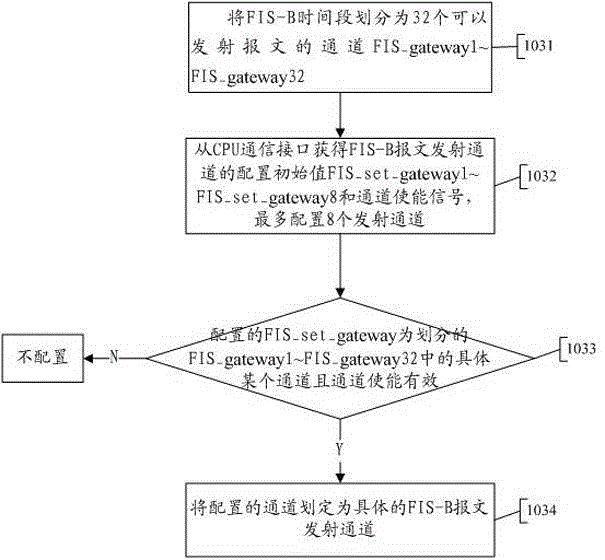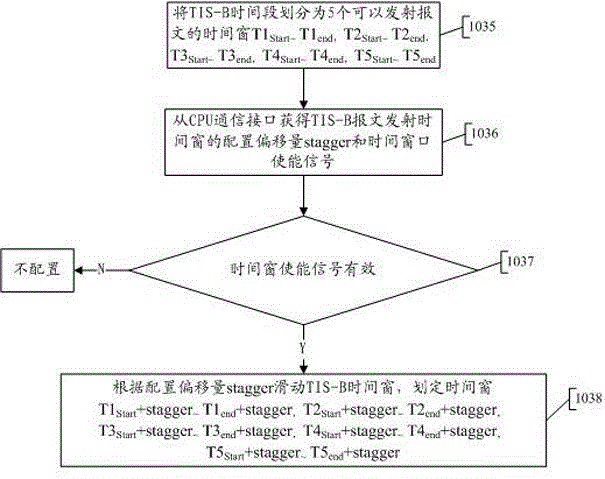Method and device for dividing and selecting random time slot for multi-channel variable time window in real time
A multi-channel, time-slot technology, applied in digital transmission systems, electrical components, error prevention, etc., can solve the problems of inability to transmit messages, low system real-time processing, and insufficient real-time processing.
- Summary
- Abstract
- Description
- Claims
- Application Information
AI Technical Summary
Problems solved by technology
Method used
Image
Examples
Embodiment 1
[0059] refer to figure 1 as shown,
[0060] 1. 1s is divided into FIS-B time period and TIS-B time period. The length of the entire FIS-B time period is 200ms, and the length of the entire TIS-B time period is 800ms. The first and last guard interval (Tkeep -start=Tkeep-end=6ms), the remaining 188ms of the FIS-B time period (TFIS), and the remaining 788ms of the TIS-B time period (TTIS).
[0061] Among them, the signal characteristics of FIS-B: 32+8*6*9232, a total of 4448 bits, each bit takes 960ns, and it takes 4270080ns to transmit a complete message, about 4.3ms. The length of the entire FIS-B time segment is 200 ms, and the first and last guard time intervals are removed, leaving only 188 ms (TFIS). Divide TFIS into 32 channels on average, and the time of each channel is about 5.8ms, which is enough to transmit a complete FIS-B message. The system can transmit up to 8 FIS-B messages per second, so configure 8 channels among the 32 channels and enable the corresponding ...
Embodiment 1
[0066] Step 1: Delineate the transmission time period of FIS-B message and TIS-B message according to the second pulse; figure 1 The present invention provides a method for real-time division and selection of random time slots with multi-channel variable time windows and a schematic diagram of time segment division in Step 101 of Embodiment 1, as shown in figure 1 As shown, the time period is divided as follows: the specific method is: starting from the second pulse, set the initial Tkeep_start as the FIS-B message transmission start protection time, and then TFIS is the FIS-B message transmission time period, you can use this time period Transmit up to 8 FIS-B messages, then Tkeep_end is the FIS-B message transmission termination protection time, then set Tkeep_start as the TIS-B message transmission start protection time, and then TTIS is the TIS-B message The transmission time period, during which a maximum of 190 TIS-B messages can be transmitted, and then Tkeep_end is the...
Embodiment 2
[0071] Embodiment two: figure 2 for figure 1 The schematic flow chart of delineating a specific FIS-B message transmission channel according to the configuration initial value obtained in step 2 of the illustrated embodiment includes:
[0072] Step 1031, divide the FIS-B time period into 32 channels FIS_gateway1-FIS_gateway32 that can transmit messages, that is, T FIS The FIS-B message transmission time period is expressed in terms of ΔT FIS For stepping, it is divided into 32 channels that can transmit messages;
[0073] Step 1032, obtain the configuration initial value FIS_set_gateway1~FIS_set_gateway8 and the channel enable signal of the FIS-B message transmission channel from the CPU communication interface, and configure 8 transmission channels at most, that is, obtain FIS_set_gateway1, FIS_set_gateway2...FIS_set_gateway8, and the enable signal is high and effective;
[0074]Step 1033, correspond to the FIS_set_gateway configured and the specific channels in the divid...
PUM
 Login to View More
Login to View More Abstract
Description
Claims
Application Information
 Login to View More
Login to View More - Generate Ideas
- Intellectual Property
- Life Sciences
- Materials
- Tech Scout
- Unparalleled Data Quality
- Higher Quality Content
- 60% Fewer Hallucinations
Browse by: Latest US Patents, China's latest patents, Technical Efficacy Thesaurus, Application Domain, Technology Topic, Popular Technical Reports.
© 2025 PatSnap. All rights reserved.Legal|Privacy policy|Modern Slavery Act Transparency Statement|Sitemap|About US| Contact US: help@patsnap.com



